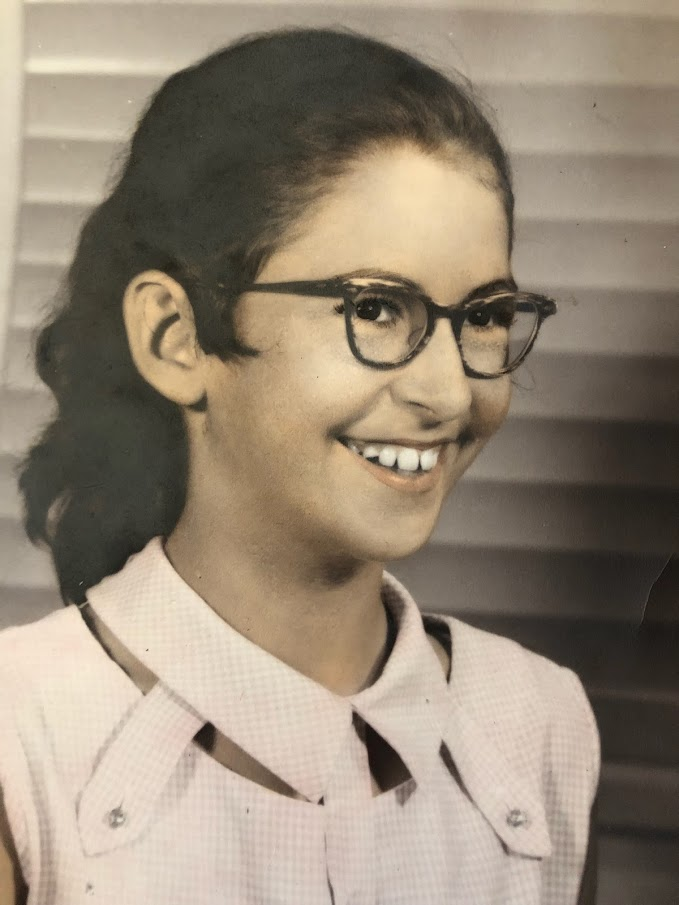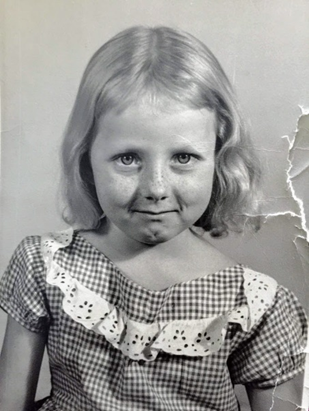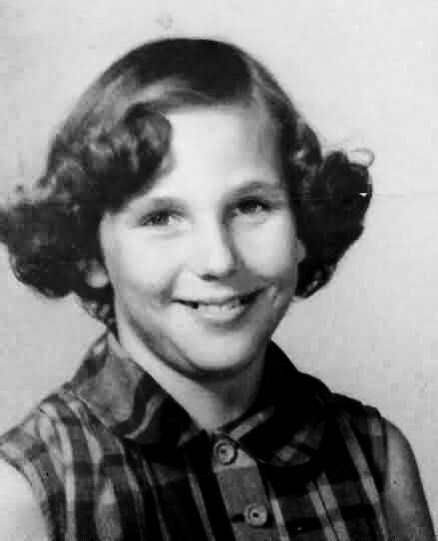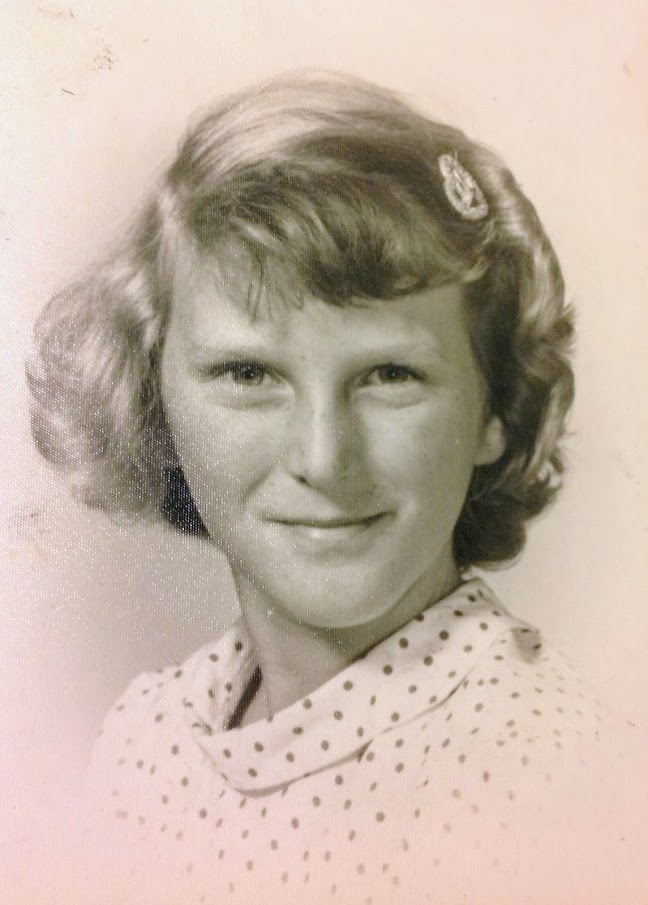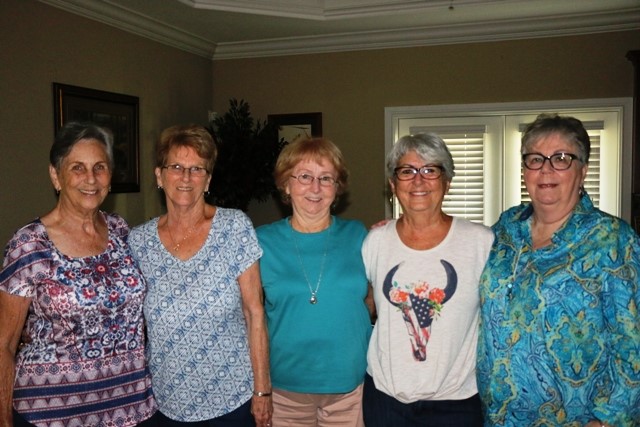
L to R: Jannette Smith Bollinger, Betty Jo (Jody) Armstrong Eleuterius, Connie Lynch, Cheryl Roper Beauregard, and Jackie Watson Johnson, 2018 (Photo by Shirley Thornton)
[spacer height=”20px”]
In August of this year, five women who have been friends for nearly 70 years took a long, slow walk down Memory Lane in a reunion at Cheryl Beauregard’s home in Flour Bluff. Sports stories and memories of games won and lost was just a part of what the women shared that day. As they sat around the kitchen table, they listened as each one spoke and helped each other remember names and places and events that they all knew at one time or another. It soon became apparent why they were so good as a team in their youth; they could read each other. One could pick up where the other left off, while at times one of them had to take charge on her own and fill in the gaps or provide the memories the others just didn’t have. Watching them giggle or gasp as they discovered new things about each other was as precious as the history they revealed about 1950s Flour Bluff and their beginnings in this little community that wasn’t yet part of Corpus Christi.
The girls’ lives crossed for the first time when they entered Flour Bluff School. Four of the five women in 1950 in Ida Magnenat’s first-grade class. (Jackie was a year behind the others.) They loved this gray-haired teacher who was an active member of the Daughters of the American Revolution. Jannette said, “I loved that woman. She was just like my mother.” They remembered fondly some of their classmates. There was Billy Fowler whose memory came with a chant. “Billy Fowler, Billy Fowler, he’s my fellar!” They spoke of Bucky Vannoy, a classmate who sometimes found himself at odds with teachers and Mr. Meeks, the bus driver.
“He got into some trouble, but Bucky had a big heart,” said Cheryl, as all the girls nodded.
Jody added, “Once I went to visit Bucky with my brother Earl. Bucky greeted us and told me to come back in an hour, and he’d have me a big chest of fish. He did. Bucky was really a good guy.”
[spacer height=”20px”]
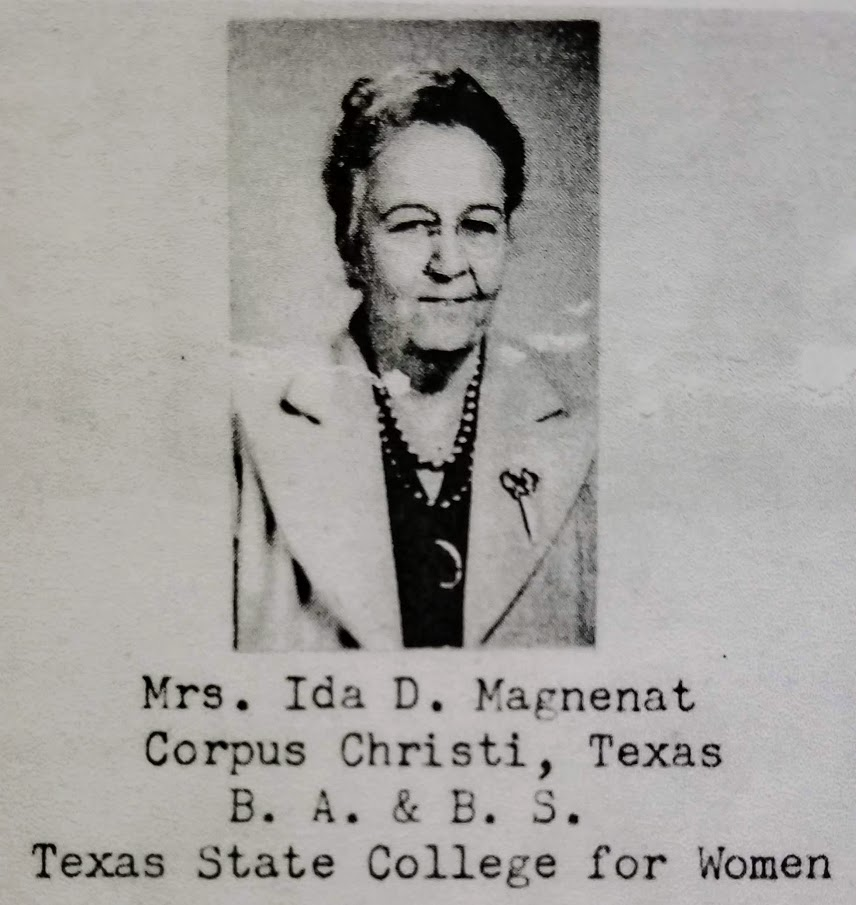
Cheryl, Jannette, Jody, and Connie met in Mrs. Magnenat’s first-grade classroom in 1950. (Flour Bluff Yearbook photo, 1947)
Cheryl Roper Beauregard spoke first. “I was born in Corpus Christi at Osteopathic Hospital and have lived in Flour Bluff all my life,” she said. Cheryl told of how she grew up in the Humble Camp near NAS Corpus Christi with her Catholic mother, Alice Ritter Roper, and Baptist father, James W. Roper; how she went from first through twelfth grade at Flour Bluff School; and how she married her high school sweetheart Bob Beauregard, an athlete who became a successful commercial fisherman and business owner. Cheryl raised four children with him: Robin, Jeff, Kristi, and Jimmy. Jimmy and his family live on a piece of the original Ritter property, as does Cheryl’s brother and sister-in-law, Butch and Marge Roper. Sister Deanna lives “in town,” as the five women still call Corpus Christi, but she has roots in the Flour Bluff sand, just like her siblings. Cheryl still resides in Flour Bluff just off Don Patricio. Her home is not even a mile from the original homestead of her great grandfather George Hugo Ritter, a Prussian immigrant who settled the Encinal Peninsula in 1890 and started the first school.
[spacer height=”20px”]
[spacer height=”20px”]
Jody added with a grin, “I remember being at Cheryl’s house when her mom was making rum balls. Her dad said, ‘Now, there’s the difference between the Catholics and the Baptists. The Catholics drink it, and the Baptists eat it.’”
Connie Lynch also has a lifelong connection to Flour Bluff. Her grandmother was Clara Johnson, daughter of Ma (Nina) Johnson, the matriarch of the Johnson family that helped settle Flour Bluff. According to a 1963 Caller-Times article, Ma Johnson moved to Texas from Arkansas in 1883 when she was 10 years old. It was here that she married Mr. H.E. Johnson and moved to South Texas with him in 1913. The family eventually moved to Flour Bluff in 1920. Mr. Johnson died in 1944 leaving Ma Johnson to tend to the children. Connie’s family, like Cheryl’s, helped settle the Encinal Peninsula. They farmed, raised cattle, and fished like so many others who chose to carve out a life between the Cayo del Oso and the Laguna Madre. She called the roll of some of the names she could remember including Aunt Potty, the Savoys, Aunt Irma, Aunt Lula, Bud Johnson, Johnny Johnson, and so many others. Before Ma died, she requested that they have a family reunion every year. “We’re coming up on our 50th reunion,” said Connie.
[spacer height=”20px”]
[spacer height=”20px”]
Though Connie was born in Corpus Christi, she moved away for a short while with her parents Alton and Alma Mahan Lynch. “My daddy got transferred to Tomball by Humble when I was little. Then, he quit, and we came back to Flour Bluff,” Connie said. “My daddy was a commercial fisherman, and my mama was a seamstress.”
Cheryl interjected, “Her daddy dated my mama.” This brought a round of laughter from the friends.
“He was going to marry her, too,” said Connie, “but she was Catholic, and he wasn’t going to raise his kids Catholic.” Another wave of laughter went around the table.
“I didn’t know your mother was a Mahan,” said Jannette. “Who was Mary Mahan?”
“She was my mother’s sister,” answered Connie.
Jannette gasped and said, “She was my mother’s best friend!”
Jannette Smith Bollinger’s family moved to Flour Bluff from Cleveland, Texas, in 1946 when she was just two years old. The base had opened, and her father, Frank Smith, came to Flour Bluff for work. Her mother, Gertie Smith, had her first child Sherry in 1935 at Spohn Hospital and swore she’d never do that again. So, the other six children were born at home. “First, they wouldn’t let my mother have any chocolate, and second, Spohn was a Catholic hospital. My mother was so worried they would baptize that baby!” said Jannette, who added that her father was Catholic, but her mother was a Seventh-Day Adventist. All seven children went to Flour Bluff School, and for the most part, were raised Baptist.
[spacer height=”20px”]
[spacer height=”20px”]
“When we first moved here, we lived on what they called ‘The Acre.’ It was on Gertie [now Gertrude Street] Street near the little lake on Lakeside Drive,” said Jannette. “We had an acre of land where my dad built a little house for us. We had an outhouse. I was in first or second grade before we had an indoor bathroom.”
“My mother passed away in 1955 of a heart attack when I was eleven,” Jannette said. “She was just 39.” Some of the women were visibly sad as they realized they were hearing this piece of their friend’s story for the first time.
Betty Jo (Jody) Armstrong Eleuterius was born in Kingsville but moved with her brother Earl and her mother and adoptive father, Mildred and Elmer Armstrong, to Flour Bluff. Elmer was a commercial fisherman and settled near the end of Laguna Shores Road where other fishing families like the Vannoys and Corkills lived. “The mom of one of my uppity friends whose dad was an officer on the base called us ‘wharf rats’ because we were from the bayfront. Actually, she called everyone off the base ‘wharf rats.’ Now we even call ourselves ‘Bluff Rats.’ Little did I know that she was making history way back then.”
[spacer height=”20px”]
To the amazement of some of her friends, Jody’s family lived without running water when she was growing up. “We got our water from the school,” she said, something that many Flour Bluff families did in those days. “I can remember my grandmother, Maude Barker, heating a big pot of water over a fire in the backyard to do the laundry. She used a scrub board just like the old days, and that was the 1950s! That part of Flour Bluff was very poor and totally undeveloped. We did have a butane tank though, so we at least had gas in the house for cooking.”
Both Jannette and Jody talked of the ice boxes their families used for refrigeration. “I can still remember that big, flatbed truck that delivered ice to our house,” said Jannette.
Connie recalled how her mother inherited some money. “Daddy built us a house on Glenoak,” said Connie, “and everybody thought we were rich! We were far from it. My daddy was a fisherman, and my mama was a seamstress. Mr. Wranosky bought the house from my dad for his own family.”
Jackie Watson Johnson, the last to join the group of friends in their youth, moved from Seguin to Flour Bluff when her dad took a job as a fireman on the base. “I met these girls through basketball,” said Jackie. “I had never played sports when we moved to Flour Bluff, and if you didn’t play sports, there was nothing to do.”
[spacer height=”20px”]
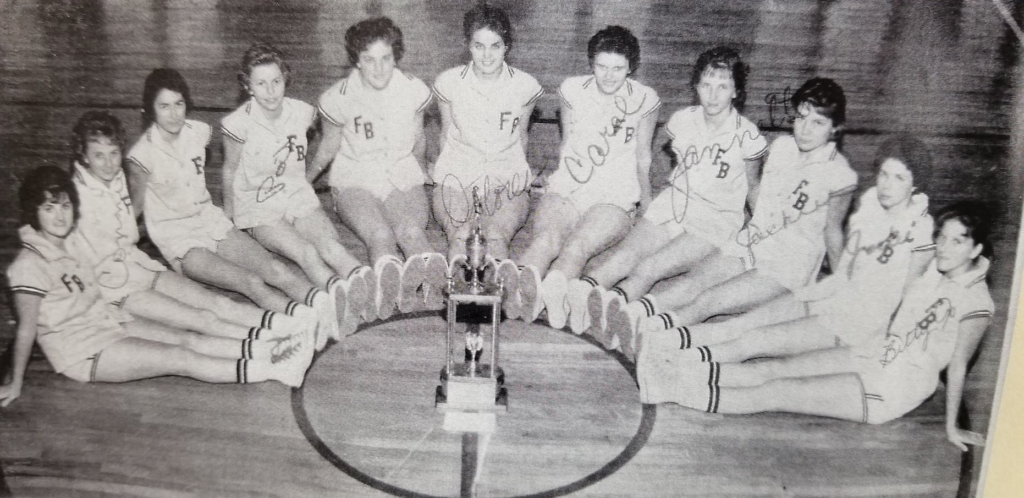
Jackie Johnson, second from the right, was in her element on the basketball court. (Photo courtesy Cheryl Beauregard)
[spacer height=”20px”]
“Remember the plane that Butch Roper talked about going down next to Hawley’s Drug Store?” said Jackie, “My daddy helped put that fire out. He was burned but thankfully not too badly. We heard the plane go down, and we knew Daddy was working, so we were worried. It took them a long time to get the fire out.”
Jackie’s family moved to Claride Street, just a few blocks from Humble Camp and the base. “We didn’t lock our doors ever,” she said. “It was a different time. I remember the empty lot at the end of Webb where all the kids in the whole neighborhood played baseball almost every day. We didn’t go home until dark. It was boys and girls of all ages, and everybody played together and had a good time.”
Janette added, “I can remember walking from The Acre across NAS Drive to Humble Camp where I’d climb the steps over the fence to go to Cheryl’s house on the other side. I was in the first grade!”
Connie recalled how her family’s house on Purdue was a “two-room shack” where her parents and their five kids lived. “I used to sit on the top of the windmill and sing while Daddy rung the necks of the chickens. When Mama said for us to get out of the house and go, we did. We’d be gone all day. Once we walked across the Oso railroad bridge and back all by ourselves.”
As young girls, these women lived in a simpler time where they walked everywhere and knew everybody along the way. Whether they were going to the base to see a show for a dime or climbing to the tops of the oil tanks to see how far they could see, they enjoyed living in a small town that they didn’t realize wasn’t a town at all. These girls were like so many in 1950s America, carefree but deeply connected to family, friends, and community.
NOTE: Be sure to check back for Forever Friends, Part II.
————————————————————————————————————
The editor welcomes all corrections or additions to the stories to assist in creating a clearer picture of the past. Please contact the editor at [email protected].
